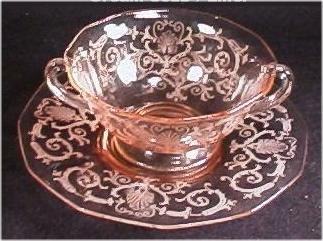National Depression Glass Association
Preserving America's Glass Manufacturing Heritage
What Is A Cream Soup Bowl?
by Kathy Eickholt
As lifestyles changed, the bowls that people used on their dining tables changed too. We'll explain bowls used in elegant and depression glass patterns from the 1920s through 1940s.
During the 1920s through mid 1940s lifestyles tended to be more
formal than today. Dinner services, whether china or glass, had
more pieces that fit specialized uses. Elegant depression glass
patterns often had several sizes  and styles of bowls, and often each
bowl had its separate, special plate to go underneath.
and styles of bowls, and often each
bowl had its separate, special plate to go underneath.
The cream soup bowl (shown at right) looks like a wide, shallow cup with two handles. Soup can be messy and the handles made it easier to hold as well as decorative. The wise hostess would put a 7 inch plate under the cream soup bowl to provide a place to put the soup spoon after use. Trojan elegant glass from Fostoria has a 7½ inch liner plate with a wide cup well that is meant to hold the cream soup.
To identify cream soup bowls, look for a piece with two handles that is relatively shallow and 5 to 6 inches in diameter. Many elegant glass patterns from Cambridge and Fostoria included the cream soup bowl, as did depression glass. You can find a cream soup bowl in Hazel Atlas' depression glass patterns Royal Lace and Florentine and in Federal's Madrid and Hocking's Mayfair. Cream soup bowls were certainly not must-have pieces and not everyone who owned a pattern had a full set. Because of this, today they tend to be among the pricier place setting pieces in many patterns.
Boullion cups were even more specialized. Fostoria's Seville had a boullion cup that looks a lot like the cream soup with two handles. It is slightly smaller, 5" across. The book Fostoria, the First Fifty Years, by Hazel Marie Weatherman, shows a catalog photo of the boullion bowl on a regular saucer.
Duncan Miller's Early American Sandwich pattern included several bowls. We show three of these in our Cat Lady Kate's Glass online store linked below. They have a fruit bowl, which is about 1 inch deep and 5 inches across, a grapefruit bowl and a finger bowl The fruit bowl is the size we would use today to serve a side dish of fruit or vegetables, or to hold ice cream. The grapefruit bowl has a flat rim and is about 6 inches across with the center section the right size for a grapefruit, about 4 inches across. The finger bowl is more V-shaped, and is about 4 inches across and about 1½ inches deep.
We don't use finger bowls frequently today but they could be useful when you serve barbeque or corn on the cob! Originally the hostess would place the bowl with water for the guests to use to lightly rinse their fingertips and blot on the napkin. In even earlier times the maid could bring around warm wet towels for guests. In today's more relaxed (and maid-free) environment, these bowls are the perfect size for food.
Nowadays casual dinnerware often has only one bowl that serves for both soup and cereal. The older elegant glass patterns from the more formal era had separate bowls as did the mass-produced depression glass. The cereal was deeper and narrower and the soup was wider and flatter. Some of the soup bowls would be difficult to eat from without tipping the bowl. It's wise to remember that in this earlier time that soup was one course in a formal meal and served in small quantities, not a main part of the meal.
If you look at Hazel Atlas' Moderntone depression glass you can find a cream soup bowl (small, two handles), a soup (wide and flat), a cereal bowl and a berry bowl! Some elegant glass patterns had even more pieces.
Berry bowls are an older name. Berry bowls were marketed in sets containing one large bowl and 4 to 8 smaller bowls.
The smaller bowls are the size we would use today for small side dishes or vegetables. They are usually about 4 to 5 inches in diameter. China patterns usually refer to this size as a sauce dish. Hocking Glass Fortune depression glass is a small pattern with only 12 pieces. It includes 3 sizes of small bowls, the 4 inch berry, 4½ inch dessert, and 4½ inch bowl with handles. Plus it has a 5¼ inch bowl that looks the size for cereal. The 4 inch size is considered the berry bowl and the 4½ inch size with handles sometimes is listed as a 2-handled berry bowl.
It's interesting how names for tableware pieces have changed. Berry bowl sets were made in the very early pattern glass and sold as berry bowl sets with one large and 4 to 8 smaller bowls. The large bowl was called a master berry bowl, usually about 8 inches across. Later patterns usually list the 8 inch bowl as a serving bowl, vegetable bowl, or sometimes describe it by shape and size, such as a 9 inch flared bowl in Fostoria's Fairfax. The "berry bowl" term shows up in some reference books for glass patterns made much later, such as Anchor Hocking's Bubble pattern. Bubble was made from the early 1940s to 1970s, yet the 8 inch bowl is referred to as a "berry bowl", not as a vegetable bowl, and the little 5 inch bowls are also called "berry bowls". It is as if the name came back into fashion.
Bowls are among the most interesting pieces to collect in depression and elegant glass. Have fun collecting!
Webmaster's NOTE: The NDGA wishes to thank the author for permission to use this article. Kathy is a dealer from Midland, Michigan. Her web site is Cat Lady's Glass.